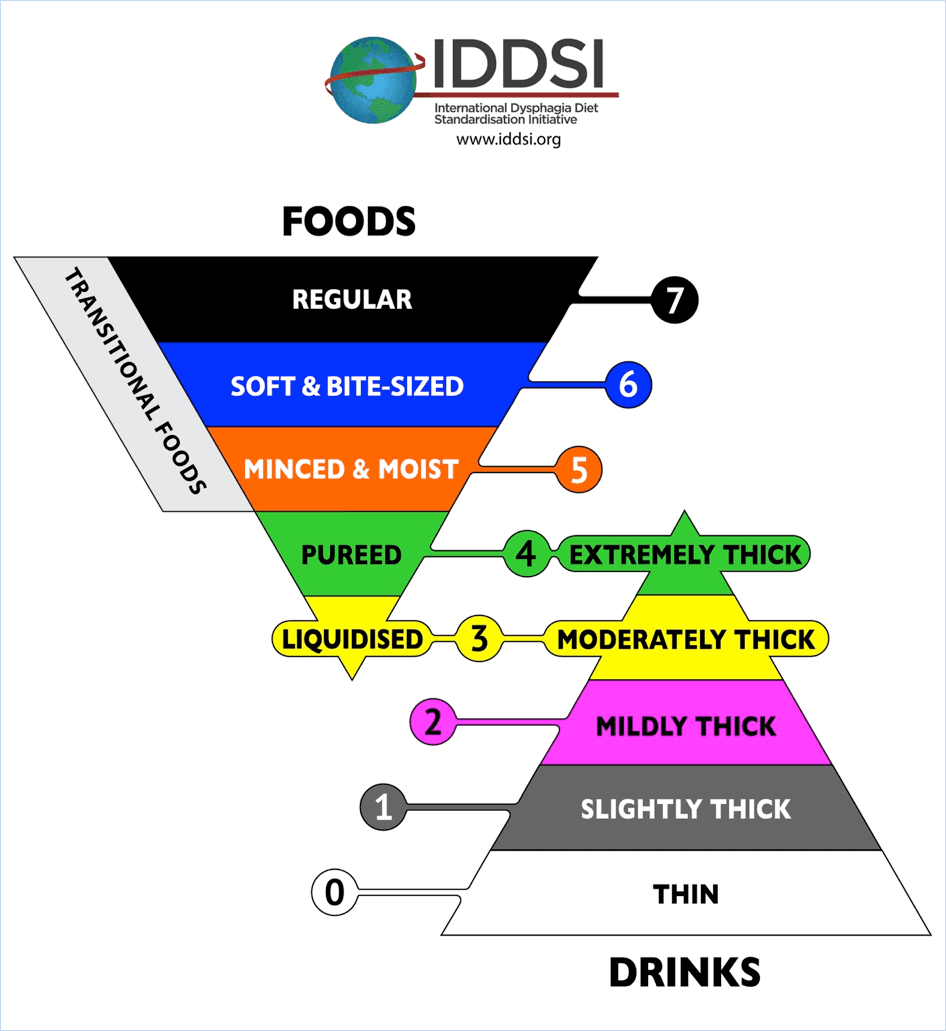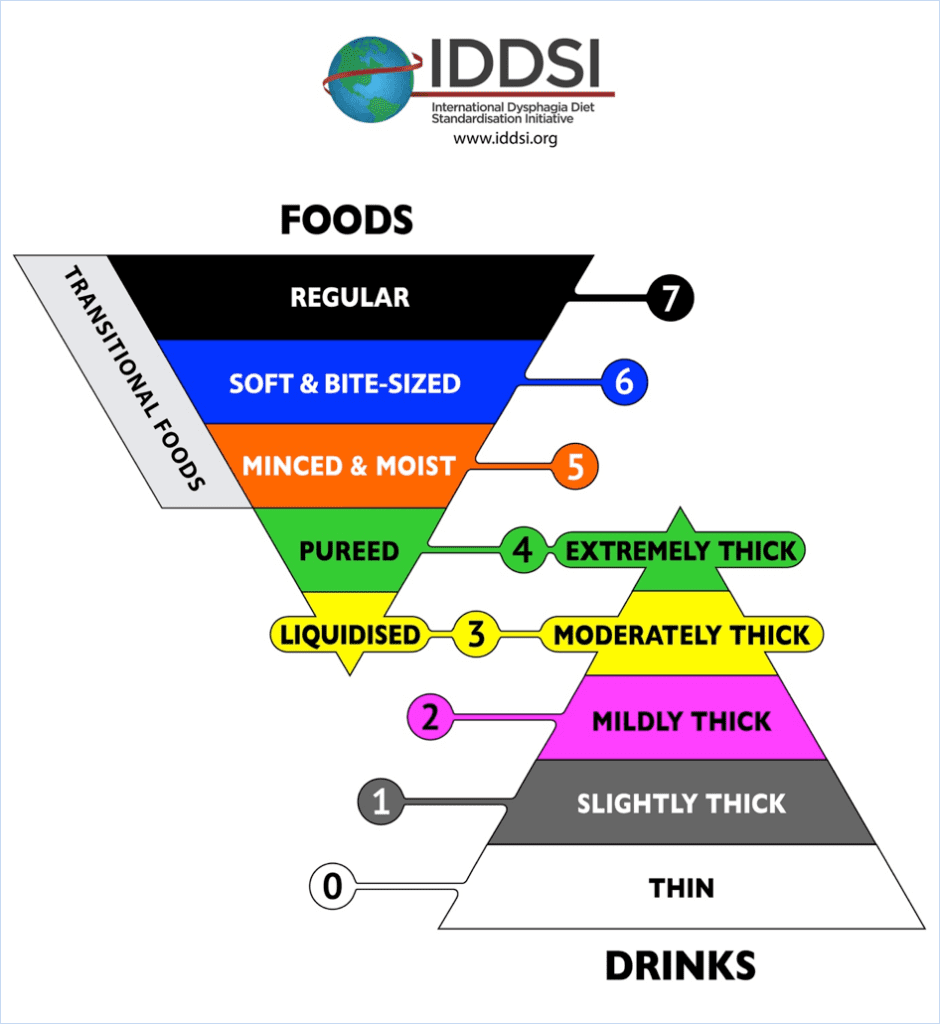About eight percent of the world’s population—350 million people—have difficulty swallowing food and liquids. This condition is known as dysphagia, and is most often managed by modifying the texture of foods or drinks by chopping, mincing, mashing or puréeing foods and thickening liquids. The goal of International Dysphagia Diet Standardization Initiative (IDDSI) is to develop globally recognized terminology and definitions for describing texture-modified foods and liquids.
Modifications to foods and liquids in a safe way help reduce the possibility of someone with dysphagia from choking, aspirating or inhaling food or fluid into the airway. Modified foods also help prevent people from becoming malnourished or developing symptoms of dehydration. These modifications are practiced around the world, but the names and thicknesses associated with modified food and liquid may vary from one setting and country to another. Without having standardized definitions and descriptors, those with dysphagia may not receive food and drinks that are safe for them to consume, putting them at risk of medical problems.
Since the IDDSI framework was first published in 2015, professional associations, regulatory bodies and the foodservice industry have been working to support implementation. Here is the latest on the initiative:
Preparation is well underway
The goal of the IDDSI was to create a framework that would be recognized around the world and be used across all age groups and in a variety of healthcare settings. The framework represents a continuum of eight levels (levels 0-7) with seven levels involving texture modification. Both food and liquid textures are included in a single scale using a dual inverted pyramid design showing foods on the top with liquids on the bottom.

Each level of the framework is identified by a color, number and label designed to improve accuracy in prescribing, preparing and providing texture-modified dysphagia diets. There is an overlapping area in the middle of the framework because certain food textures share movement or flow characteristics with thickened liquids. Food and fluid levels are defined by characteristics/descriptions, physiological rationale for each level, and IDDSI-specific testing methods. For example, if you work in a healthcare kitchen and need to make lemonade to a particular thickness, there’s a fork test—dip a fork in the liquid and then clock how quickly the liquid falls from the fork’s tines to determine whether it meets “Liquid Level 3—Moderately Thick.”
The United States is in the “aware” phase of the Monitor-Aware-Prepare-Adopt (MAPA) process outlined by IDDSI. IDDSI is actively supporting the awareness and implementation of the framework at the organizational level through the development of new resources.
Providing the ability to move forward
Tools available on the IDDSI website (iddsi.org) have expanded to include audit sheets for each level of liquid and food based on testing methods and descriptions. There’s also IDDSI abbreviations for use with foodservice computer software and downloadable presentations to assist with educating staff.
For further help, there’s an IDDSI YouTube channel with food- and fluid-testing videos, as well as recorded webinars on IDDSI updates and experiences of implementing IDDSI in various healthcare settings.
Additionally, IDDSI has created implementation guides with a 12-month calendar of events to help healthcare providers as they monitor their progress with residents and patients.
The IDDSI site also offers webinars and publications, including research articles and reports, FAQs and access to all newsletters. Information also can be accessed via the free IDDSI app (available for iOS and Android devices) and by following IDDSI on Twitter @iddsi_org
Supporting the initiative
While organizations recognize the potential for IDDSI to have a positive impact on caring for people with dysphagia, they understand it will take time, energy and commitment to implement the framework.
You will start noticing label changes on thickening agents or pre-thickened product to support the new terminology. Many manufacturers have started to labeling their products with IDDSI terminology and nomenclature; however, during this transition, you may notice dual labels representing both IDDSI terminology and National Dysphagia Diet terminology.
In the United States, IDDSI has the support of the Academy of Nutrition and Dietetics (AND) and the American Speech Language Hearing Association (ASHA). The most recent Nutrition Care Manual includes a new section on IDDSI.
What Gordon Food Service is doing
Gordon Food Service supports IDDSI. The Nutrition Resource Center understands the importance of the initiative and its focus on safety for those living with dysphagia and their caregivers at all levels. The Nutrition Resource Center will be focused on solutions to help operators through the implementation process. That may include educational webinars, training topics, videos, Idea Center articles and support in Cycle Menu Management.
Note: The IDDSI Framework and Descriptors are licensed under the CreativeCommons Attribution Sharealike 4.0 Licence. (c) The International Dysphagia Diet Standardisation Initiative 2016. Attribution is NOT PERMITTED for derivative works incorporating any alterations to the IDDSI Framework that extend beyond language translation. Modification of the diagrams or descriptors within the IDDSI Framework is DISCOURAGED and NOT RECOMMENDED. Alterations to elements of the IDDSI framework may lead to confusion and errors in diet texture or drink selection for patients with dysphagia. Such errors have previously been associated with adverse events including choking and death.











